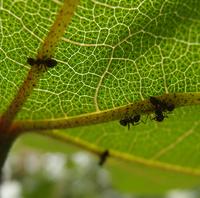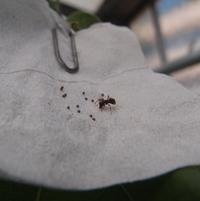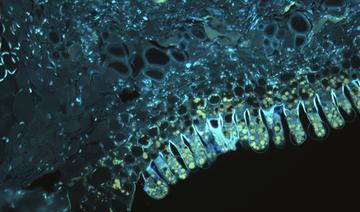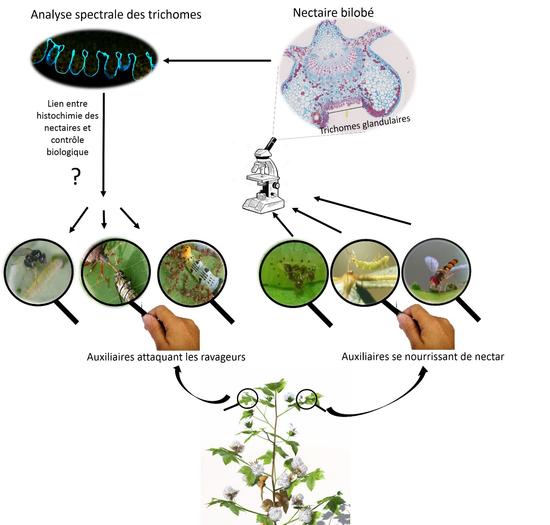NEF
Last update: 28 March 2018
NEF... extra-floral nectars
Climate change and the pressure on natural resources resulting from population growth mean new challenges for food security worldwide. Agriculture must adapt in order to reconcile improved productivity and resilience of production systems. Crop pests, which cause the loss of an estimated 35% of potential crop yields worldwide, are still a constraint on improving productivity (Oerke 2006, Sundström et al. 2014). Some of these yield losses result from the vulnerability of the varieties grown to pest attacks. Many of the natural herbivorous pest resistance traits found in wild varieties have been lost through breeding for yields and quality, with insecticide protection (Warschefsky et al. 2014). To reduce dependence on pesticides and guarantee food security, the whallenge is to integrate into cultivated varieties the resistance traits found in wild varieties. Such breeding programmes should encompass knowledge of the defence reaction mechanisms of wild varieties, which modulate the ecological interactions between plants and beneficial and harmful insects. Cotton is an excellent biological model for comparing defence strategies against herbivorous pests between wild and cultivated varieties (Loughrin et al. 1995). Those defence strategies include extra-floral nectaries (NEF), which are the structures that emit the nectare that attracts predators or parasiutoid wasps, hence fostering pest regulation services (Hagenbucher et al. 2013).
A brief look at the literature on the role of floral nectar in interactions between plants and insects shows that miner constituents of nectar, such as metabolites or secondary compounds, can play a crucial role in mediating those interactions (Adler & Irwin 2012; Nepi 2014). For instance, the presence of low doses of nicotine in flower nectar optimizes the time spent by visitors on a flower (Kessler & Baldwin 2007). Although there is little information on the type of secondary compounds in extra-floral nectar, a recent study revealed the presence of alkaloids and flavonoids in Passiflora extra-floral nectar (Cardoso-Gustavson et al. 2013). The authors point out that the low concentration of these compounds in nectare is sufficient to affect the metabolism of those collectors that have a mutualistic relationship with the plant. Histochemical analyses of floral nectar from cultivated cotton trees conducted recently at the Montpellier platform revealed the presence of different types of secondary compounds, such as flavonoids, terpenes and caffeic acid derivatives, once again raising the question of the role of secondary compounds in regulating interactions between plant nectar and insects. Astonishingly, despite its importance, nectar (and nectaries) has not been widely studied by the scientific community (Heil 2011) and, although new classes of substances continue to be detected in floral nectar secretions, we do not know anything about the defensive role of nectar constituents other than sugars and amino acids.
|
|
|
The main aim of the project is to characterize the ecological function of minor constituents found in nectar secretions from wild cotton trees. The idea is to restore or mobilize these functional traits in cultivated varieties, in a manner that is compatible or in synergy with biological control. The specific objectives of the project are to:
- characterize the secondary compounds (and the structures that secrete them) in ther floral nectare secretions of cultivated and wild cotton trees, through histochemical and chromatographic analyses
- identify the entomofauna that visit extra-floral nectare structures, with particular emphasis on biocontrol agents, eg parasitoids and predators, including ants.
To obtain an estimate of biological control, it is necessary to measure predation or parasitism rates on sentinel preys, and the damage caused by plant-eating insects. the results should enable us to establish a link between the extra-floral nectar structure of cultivated and wild cotton trees and identify the insects attracted by extra-floral nectars and the chemical compounds present and identify the insects attracted by extra-floral nectars and the role they play as biological control agents (see diagram 1).
Funding: CIRAD, Action CRESI
Researcjhers involved: Ana L Llandres (CIRAD-AIDA), T. Brevault (CIRAD-AIDA - Biopass Dakar), Janine Jean (CIRAD-AIDA), R. Goebel (CIRAD-AIDA), Jean-Luc Verdeil (CIRAD-AGAP), Anne Clement-Vidal (CIRAD-AGAP), Julien Haran (CBGP)
Schéma
Last update: 28 March 2018




